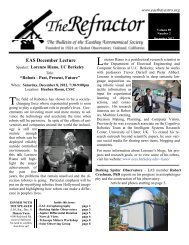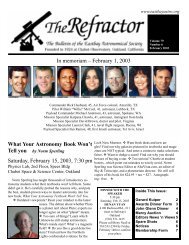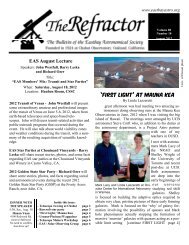May - Eastbay Astronomical Society
May - Eastbay Astronomical Society
May - Eastbay Astronomical Society
Create successful ePaper yourself
Turn your PDF publications into a flip-book with our unique Google optimized e-Paper software.
Corvus, the Crow<br />
By Ellis Myers<br />
Corvus is a lesser, but ancient, constellation that is found<br />
ten to twenty degrees west of the bright star Spica, where it<br />
forms a trapezoidal shape of six naked-eye stars in a lonely<br />
part of the sky. There are some interesting things to look for<br />
here, however, whether you have just binoculars or whether<br />
you have a Hubble Space Telescope.<br />
The star designated Alpha is not the brightest, nor does it<br />
take its place as one of the corners of the quadrangle. It may be<br />
presumed that it once was brighter than its current magnitude<br />
of 4.2 to have earned its first-place name. The brightest star is<br />
Gamma Corvi, also called Gienah in reference to the wing of<br />
the crow, using the Arabic term for wing. Algorab (Delta<br />
Corvi) is also from the Arabic, and means The Raven. It is a<br />
fine double star, with components of magnitudes 3.0 and 9.2<br />
separated by 24.2 arcseconds. Corvus has two triple stars, too,<br />
S1604 and S1669. Both of these stars are about sixth magnitude.<br />
Two variable stars are of note. R Corvi is a Mira-type star<br />
which varies in brightness from magnitude 6.7 to 14.4 over a<br />
period of about ten months. A very faint cataclysmic variable<br />
star, TV Corvi, was found by Clyde Tombaugh in 1931. This<br />
star can be monitored with a medium-sized telescope.<br />
Certainly the most curious object in Corvus is the pair of<br />
colliding galaxies called the Antennae. An object for a medium-sized<br />
telescope, it shines with light equivalent to that of<br />
an 11th-magnitude star. Long-exposure photographs reveal<br />
evidence that the turmoil of the collision of the two galaxies<br />
has spun off some of the component stars to form lengthy tails.<br />
[ 2 ]<br />
NGC 4038/4039 from ground-based<br />
telescope: shows the tenuous wisps<br />
of the antennae. The area of the<br />
HST image is indicated.<br />
The Antennae: Galaxies in Collision<br />
– HST image. Credit Bradley<br />
C. Whitmore, STScI<br />
It is these tails, which give<br />
the appearance of the graceful<br />
antennae of insects, that<br />
led to the name. The tails<br />
are also the scene of new<br />
star formation engendered<br />
by the increased density of<br />
gas and dust in these regions<br />
of interaction. Recent studies<br />
using ultraprecise measurements<br />
of pulsar timings<br />
are expected to give further<br />
insight into theories of galaxy<br />
mergers. See the article<br />
in the <strong>May</strong> 2002 issue of Sky<br />
& Telescope for more on<br />
this subject.<br />
There are two ancient<br />
legends concerning Corvus<br />
and Apollo. It is said that<br />
Apollo, god of the Sun who<br />
rode daily across the sky in<br />
his chariot, sent a beautiful<br />
silver-white crow to watch<br />
over his lover, Coronis, during<br />
his absence. But the bird was inattentive to its duty and<br />
Coronis was tempted and became unfaithful. When Apollo<br />
learned of this, he became so angry that he turned the crow<br />
black forever.<br />
The other story is of the time Apollo grew thirsty from the<br />
heat of his journey carrying the Sun, and he asked Corvus to<br />
fill his cup with cool water. The crow flew at once to the fountain,<br />
but saw a fig tree nearby and it stopped to rest among the<br />
shady leaves. The fruit of the tree was not yet ripe, and Corvus,<br />
who always managed to get in some kind of trouble, lingered,<br />
waiting for a chance at the luscious figs. But then, Corvus<br />
had a guilty conscience and on his way back to Apollo<br />
caught a water snake and carried it in its talons. The crow then<br />
claimed that the snake had attacked it and caused the long delay.<br />
But Apollo easily saw through the deception and placed<br />
the bird, Corvus, the cup, Crater, and the water snake, Hydra,<br />
all among the stars. !





